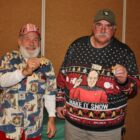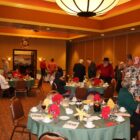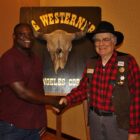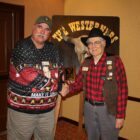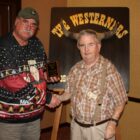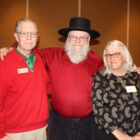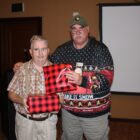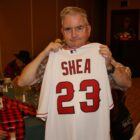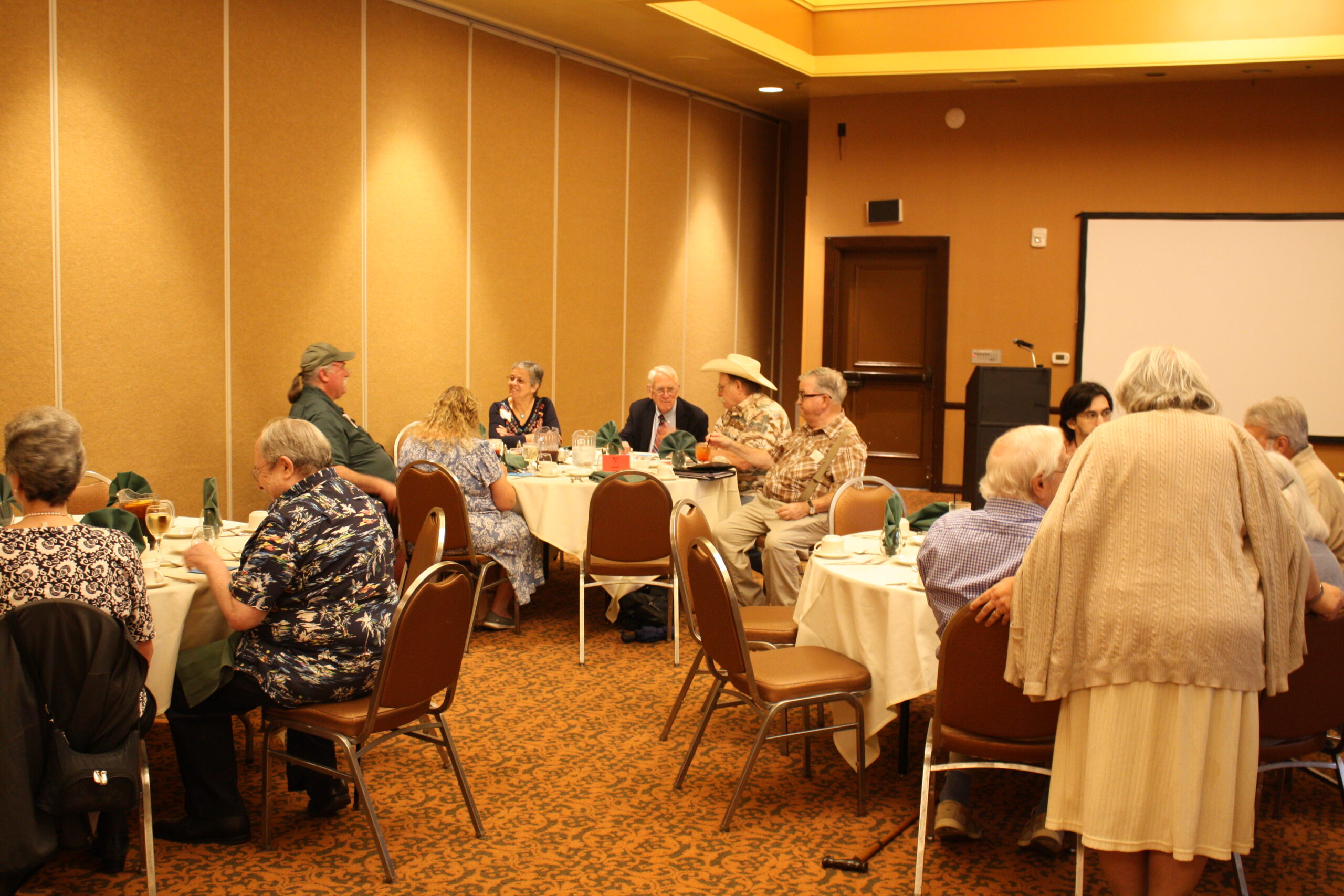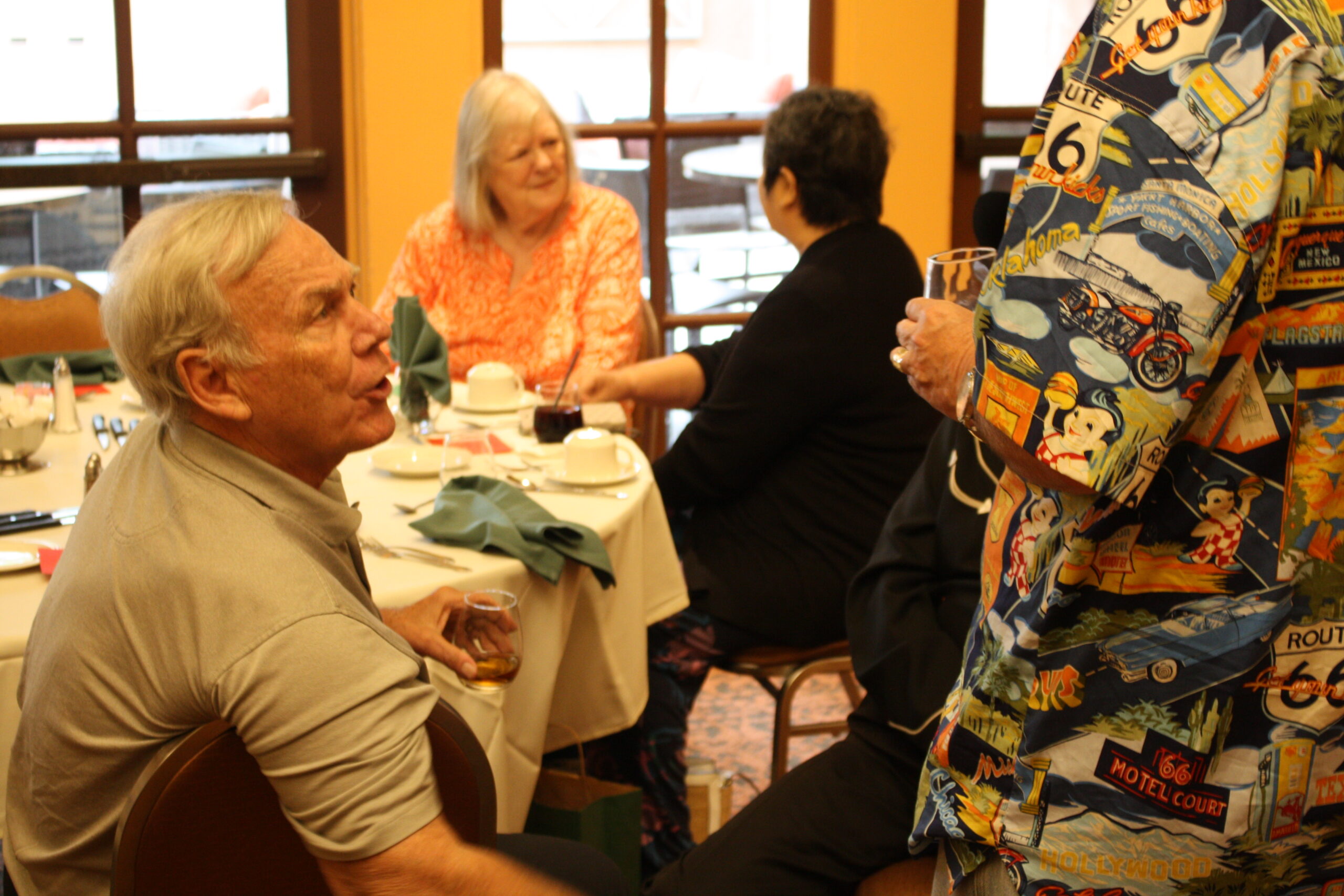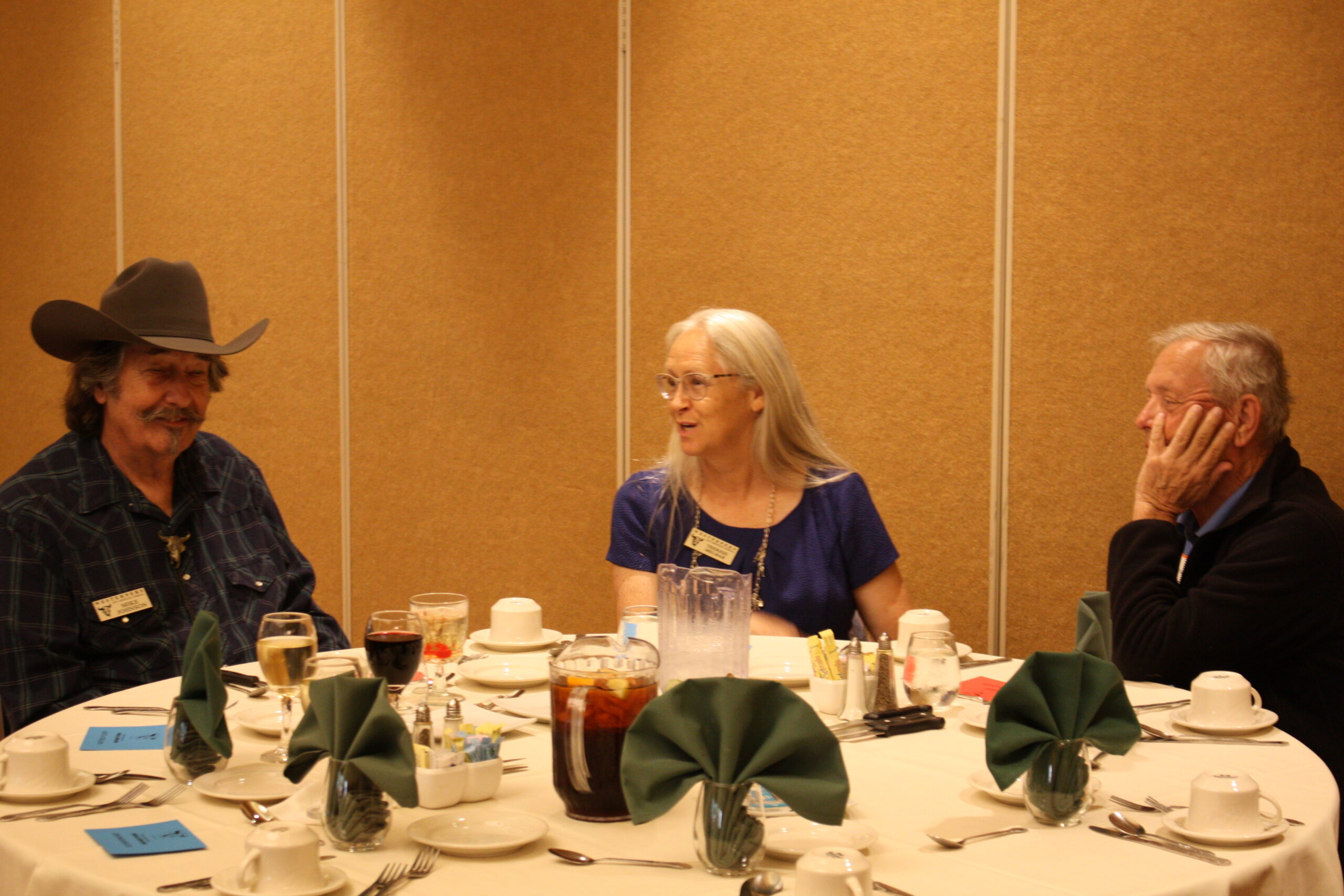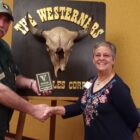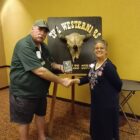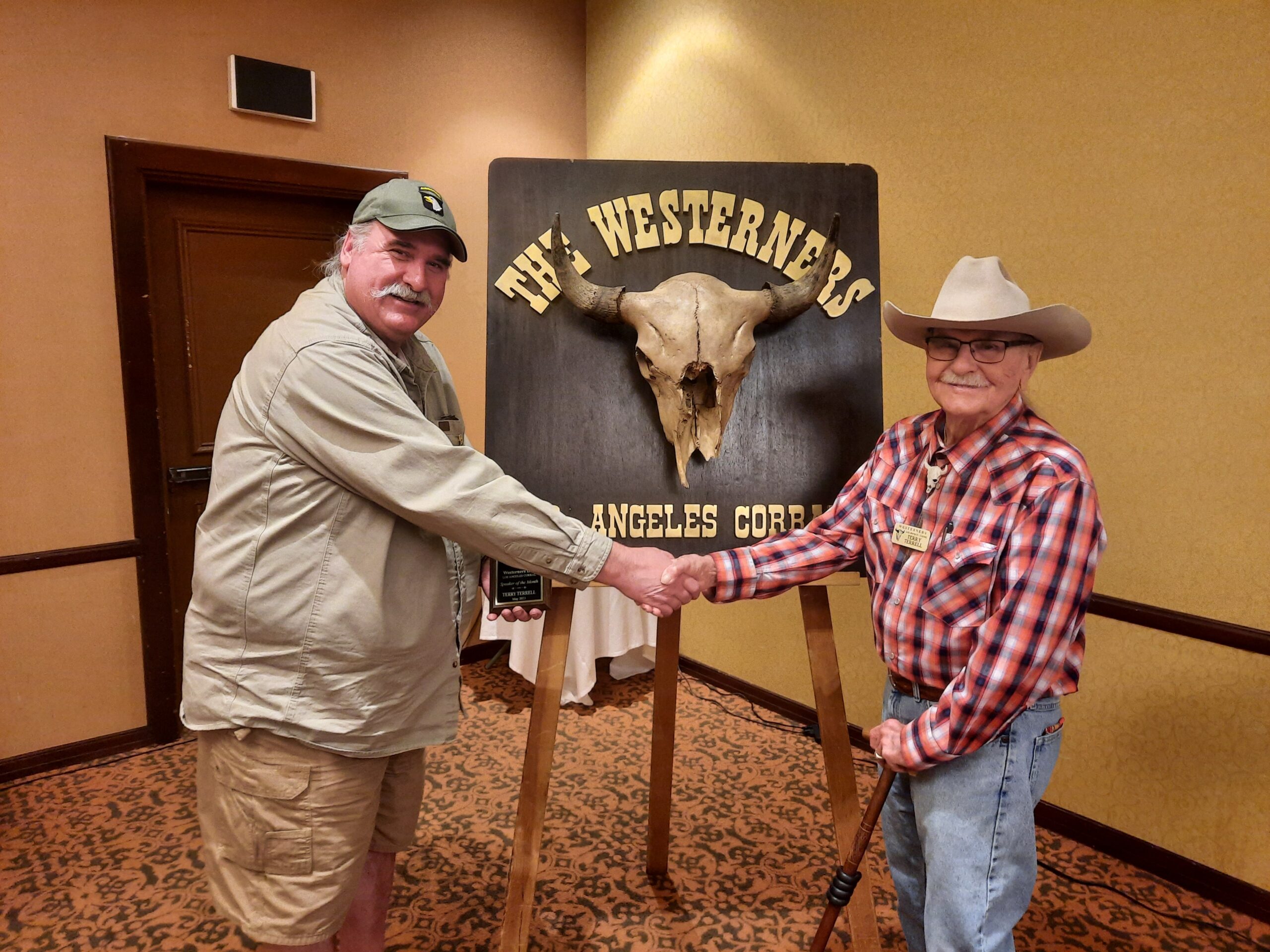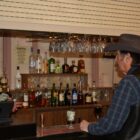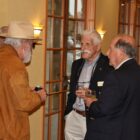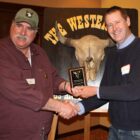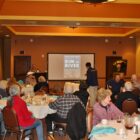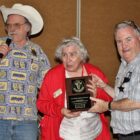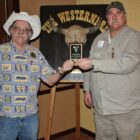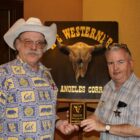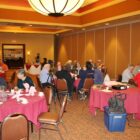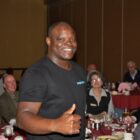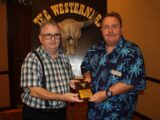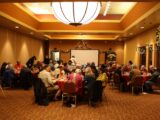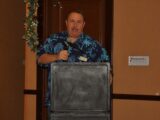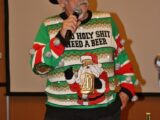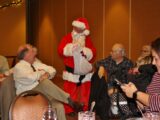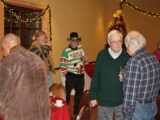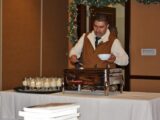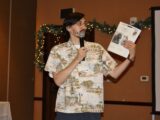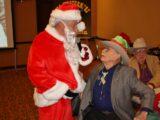Roundup: December 13th 2023
Westerners December 2023 Flyer
Roundup Synopsis
TBD
Photos from the Roundup
Roundup: July 12 2023
Westerners-July-2023-Draft-I-Roundup-Flyer-CORRECTED-6.18.23
Roundup Synopsis
TBD
Photos from the Roundup
Roundup: May 10 2023
Westerners-May-2023-IT-IS-A-GO-2
Roundup Synopsis
The Los Angeles Corral’s own Terry Terrell spoke at the May Roundup about the colorful, high-flying life of Florence Leontine Lowe, better known as Pancho Barnes. In another installment of what could come to be known as our Women of the West series—following Ed Anderson’s March talk, Pioneers in Petticoats—Terry directed our attention to the rich world of aviation and dude-ranching in the first half of the 20th century, that has become so emblematic of our own city’s historical character. Part rancher and restaurateur, part pioneering aviatrix and arial bootlegger, part hostess and perhaps even part madam, Pancho Barnes’ eccentric life added more than a few dabs of color to the mural of her unique character.
Though she was born Florence Leontine Lowe, granddaughter to Thaddeus Lowe, it was under her moniker “Pancho” and married name Barnes that she would gain fame. Pancho opened a ranch near Muroc Field (the future Edwards Air Force Base) in the mid-1930s which became home to the “Happy Bottom Riding Club.” Its name came from a remark by a guest after a ride on Pancho’s horse. The restaurant and inn, along with its own private airstrip, drew the rich and famous (and rugged) to the ranch in droves. In my favorite anecdote of the evening, Terry described the circumstances around legendary test pilot Chuck Yeager being “sundowned” at the ranch.
Out riding late one day in 1947, Chuck Yeager returned to the ranch after sundown. Thanks to the low light, Yeager didn’t notice that the corral gate, open when he began his ride, had been shut some time earlier. The horse he was riding sure noticed, though. When it stopped abruptly at the gate, Chuck was sent base over apex, breaking a few ribs on touchdown. One wonders if the libations proffered by Pancho at the ranch played a role in this misfortune. Regardless, Chuck had a job to do, broken ribs or no. The next day he closed the cockpit on Glamorous Glennis—the X-1 rocket plane named after his wife—with the aid of a broomhandle, and flew into the history books faster than the speed of sound.
Pancho never flew quite so fast, though she did best Emilia Earhart’s women’s speed record in the ‘30s. Barnes also formed a Hollywood union of pilots, and provided the dogfight sounds for Howard Hughes’ epic Hell’s Angels movie in 1930. A crack-pilot, ready hostess, and peer to some of the biggest names of her time, Pancho Barnes was a fixture for decades in the gritty and glitzy world of Hollywood’s Golden Age. It’s tough to think of a more fitting embodiment of the spirit of Southern California in that era.
Pancho was a one-of-a-kind lady, and an inspiration for all the adventurous types to follow. Let’s find more Pancho Barneses to celebrate. Let’s make this Women of the West series a reality. Who’s next?
— Alan Griffin
Photos from the Roundup
Roundup: April 12 2023
WLAC-Los-Angeles-Corral-4.12.23-RoundUp-Flyer
Roundup Synopsis
The Los Angeles Westerners gave a warm Southern California welcome to author and 4th-generation Arizonian Tom Zoellner during our April Roundup. Zoellner discussed the history of Arizona and his travels within it, which is the topic of his recently-published memoir, From Rim to River.
This book is Zoellner’s personal love letter to his home state of Arizona, with which he has a complicated relationship. The memoir revolves around his 2019 790-mile journey along the Arizona Trail traversing the entire north-south length of the state of Arizona from the Utah state line near Red Rock Country to the Mexican border. As Zoellner traveled down this historically scenic route he was inspired to compose essays for his memoir on Arizona copper mining, border crossing paths, dirty politics, Apache culture, drinking water, local cuisine, violence, and the Grand Canyon.
The origin of Arizona’s name is disputed, but Zoeller believes it likely means “the Good Oak Tree” in Basque, the language spoken by its first European settlers from Spain’s Pyrenean frontier. Arizona history has highs and lows, which were metaphorically tied to the geographic landscape traveled by Zoellner north-to-south down the Arizona Trail. The highest point in Arizona is a domant volcano named Humphreys Peak, and its lowest point, at only 72 feet above sea level, is a sad, dried-up portion of the Colorado River near the Mexican Border. Nearby is a historic border crossing named Camino Del Diablo, Spanish for “the Devil’s Road,” which was originally used by Spanish friars in the 18th century. Today this dirt road is used as a border crossing. Border patrol agents drag tires behind their vehicles to regularly smooth this road, so that crossing migrants leave more obvious footprints that can be tracked.
As Zoellner reached the end of the Arizona Trail, he discussed the state’s present controversies and contradictions. One is the epidemic of sprawling master-planned communities growing throughout Arizona like mushrooms. These are decorated by faux-Tuscan aqueducts and water-guzzling palm trees. While ugly and wasteful of land and water, these suburbs nevertheless provide affordable housing for working-class families. While he was on the subject of water Zoellner mentioned the La Paz County aquifer theft which resembled the plot of the classic movie Chinatown (1974) dramatizing Los Angeles’ alleged pillaging of the Owens Valley’s water resources. Outside of water, the most important natural resource in Arizona is copper, which is mined throughout the state, and also lies in the lands of the Apache tribe in a place called Oak Flat. Yet despite producing two-thirds of the copper in the nation, Arizona’s state capitol building inexplicably bought the copper for its dome from Pennsylvania. It is these foibles that make Arizona so perplexing and endearing.
Many thanks to Tom Zoellner for his entertaining and fascinating talk, and please give his memoir From Rim to River a well deserved read.
— Darran Davis
Photos from the Roundup
Roundup: March 8 2023
WLAC-Los-Angeles-Corral-3.8.23-RoundUp-Flyer
Roundup Synopsis
March saw the Corral greeted by Ed Anderson and his presentation, Pioneers in Petticoats: Women’s Influence in the Founding of the National Parks; a Tribute to Shirley Sargent, “Yosemite Tomboy.” Those who frequent our Roundups are likely familiar with the “Father of the National Parks,” John Muir. But as the old saying goes: “Behind every great man is a great woman,” or in this case, dozens of them. As Mr. Anderson expounded, men like Muir may have been the face of the early conservationist movement, but the founding of Yosemite and of our other treasured National Parks would not have been possible, nor nearly as comfortable, without the seldom-lauded efforts of the many women active within the West’s rugged hinterland.
First on the list of wonder women was Jeanne Carr, the “Spiritual Mother” of John Muir. Muir met Carr at the Wisconsin State Fair, and soon became a friend to her and her husband, Ezra, a professor at the University of Wisconsin. As Ed tells it, it was Jeanne who advised Muir throughout his adult life, introducing him not only to Ralph Waldo Emerson, but also to his future wife. Though she only visited Yosemite once, in 1870, her impact on it as a National Park is difficult to overstate.
Of the women who resided in Yosemite, two to highlight were innkeepers Isabella Leidig and Mary Peregoy. Ms. Leidig was the proprietor of Leidig’s Hotel, and Ms. Peregoy ran the Mountain View House, an inn that became legendary among the socialites who vacationed there. It’s not hard to imagine what these establishments meant to early Yosemite adventurers. These little oases of homey goodness nestled within the spectacular wilds would have been quite a relief from the rigors of the dusty track from Clarke, the last stop on the railroad outside of Yosemite.
While Leidig and Pergoy were caring for the boys, other gals like Sarah “Sallie” Dutcher and the Sweet Sisters were out in the park playing with the boys. Mr. Anderson’s research suggests that Dutcher was the first woman to climb the back side of Half Dome, in December 1875, with George Anderson, who was the first (documented) to ever climb it earlier that year in October. The evidence for Ms. Dutcher’s accomplishment was an earring of hers, found a few years later by another group of climbers. The Sweet Sisters were the first women to climb Mt. Lyell, and the first to descend into the Tuolumne Canyon. They also set a fashion trend wearing billowy gaucho-styled trousers. Cinched below the knee with gaiters, these pants were more practical than the petticoats eponymous to Ed’s presentation.
Whether they were directive, doting, or daring, the women profiled by Mr. Anderson in Pioneers in Petticoats, and countless others across the U.S., were instrumental in the popularization of Yosemite, in particular, and our other National Parks, in general. Perhaps in the future, the quote will read: “Behind every great man are dozens of appropriately dressed women.” Better yet, in the future, perhaps such distinctions of gender will be unnecessary when discussing the greatness of such intrepid people among us.
— Alan Griffin
Photos from the Roundup
Roundup: February 8 2023
WLAC Los Angeles Corral 02.08.23 RoundUp Flyer
Roundup Synopsis
Taken From Branding Iron 309 Winter 2023.
Firearms history through the lens of multiple generations of shooting Dillons. That was our treat in February, as the L.A. Corral’s own Dr. Brian Dillon regaled attendees with a swift, yet detailed, overview of the “shootin’ irons” of Western American history. From the smooth-bore matchlocks of Spanish first contact, to the modern, rifled auto-loaders of the 20th century, the guns that won the West ranged far beyond just the famed 1873 Winchester. We were pleasantly reminded of this fact by the variety of arms, and the folks who wielded them, presented by our eminently qualified former sheriff, and firearms instructor, Brian Dillon.
The aforementioned matchlocks may have been the first firearms present on the continent, but as Spain decided to leave, and stay gone, for a few centuries after their initial introduction in the North, these early irons had no impact on the history of the American West. Rather it was the muskets and rifles of the late 18th and early 19th centuries that first ventured into the West. Lewis and Clark’s expedition made use of later flintlock technology on their epic foray into the new American frontier; the first significant use of firearms west of the Mississippi.
Intrepid trappers, late of the old frontiers in what we now call the Southeast, were among the first to put long irons to use in the further reaches of the West. American adventurers in these early days preferred Pennsylvania rifles, while Canadians pushing west were more known for their use of smooth-bore muskets. The newly-invented percussion cap was too expensive and scarce to be of much utility in the unsettled country, and flintlocks remained in significant use by self-reliant types well into the middle of the 19th century.
The Gold Rush created a huge demand for iron in California, particularly of the defensive variety (after all, nobody will protect your claim but you). Use of the percussion cap quickly made revolvers the standard sidearm of every hunter, trapper, and miner in the rough new country. Perhaps the most iconic arm of the Gold Rush was the 1851 Colt Navy revolver. Six shots ready at the hip were invaluable in this lawless land.
The next major development in firearms was the metallic cartridge. Waterproof and durable, it made reloading a snap, and allowed for reliable mechanisms beyond the revolving cylinder to be used in chambering rounds. One such mechanism was the unforgettable lever action. Patented in 1854 by the Volcanic Repeating Arms Co., it evolved into the action used in the Winchester Model 1873, fabled as “The Gun that Won the West.”
Smokeless powder followed as the next significant leap in the technology of shooting irons, and its introduction heralded the end of the Old West. The Krag-Jorgensen was the first gun adopted by the U.S. military to utilize smokeless powder. There was no turning back from here, and on came the 1903 Springfield of WWI fame, followed by the Colt M1911. A thoroughly modern selfloading pistol, the 1911 represented the end of Old West arms, as by the time of its adoption, the West had largely been won.
The history of the American West can be described fairly thoroughly by telling the history of its weapons. Likewise, the history of American firearms can be largely understood through examination of our country’s westward expansion. And to have those descriptions provided by a compatriot whose ancestors were present on both avenues of that historical journey is a privilege we Westerners should relish. Many thanks to Brian for this presentation.
— Alan Griffin
Photos from the Roundup
Roundup: January 11 2023
Westerners-January-11-Roundup-Flyer
Roundup Synopsis
Taken From Branding Iron 309 Winter 2023.
The Ronald Reagan Presidential Library and Museum is located on a steep hill through the Santa Susana Pass in beautiful Simi Valley, California. It began its mission in 1991 to preserve all of Ronald Reagan’s presidential and personal belongings. The Reagan Library and Museum’s claim to fame is the Air Force One Boeing 707 that former President Reagan himself flew on. The speaker at the Westerners’ January 2023 Roundup, Supervisory Archivist Ira Pemstein, provided a unique insiders’ perspective into the workings of this remarkable institution.
The presidential library system developed gradually over time. Initially, presidential records were a former president’s personal property after his tenure of office, unless voluntarily given to the government as a deed of gift. The handling of records became more formalized with the Presidential Libraries Act of 1955. This act meant that once a president constructed his own building, the National Archives could donate the former president’s work to the library. The second law which came in 1978 was the Presidential Records Act, which specifically required all of former President Richard Nixon’s records to remain in Washington D.C., and not be taken anywhere outside of fifty miles from the capital. The Presidential Records Act also transferred ownership of all documents acquired or created during a presidential term to the federal government, to be managed by the National Archives. Ronald Reagan was the first president to be affected by this law, and all the libraries since Reagan have fallen under the Presidential Records Act.
The Freedom of Information Act allows the public to request specific documents from the Ronald Reagan Presidential Library. Most of the records predate the internet and are paper-based, and have yet to be digitized. Some of the archives are preserved in airtight containers and folders, or are refrigerated. Everything mentioned about the president by the three major broadcasting networks were recorded by the White House, including all the debates, campaign events, and Bob Hope specials. The Audio-Visual Archivist oversees photographs, film reels, and audio and video cassettes. The original formats can be viewed on VHS players and film projectors, which are preserved just as carefully as the forty-year-old media that they play.
The Ronald Reagan Presidential Library has 65 million pages of documents that cover Reagan’s entire life, as well as two-thirds of his career in Hollywood and his term as the Governor of California. The family-operated Ronald Reagan Foundation supplements areas that the federal government cannot, because the material from before and after his presidency does not belong to the federal government. Here is where the Reagan Foundation and the federal government come together. The Reagan family has custody and ownership of the pre- and post-presidential items that are housed at the Ronald Reagan Library and the federal government serves them to the public with the family’s permission.
— Darran Davis
Roundup: December 14, 2022
WLAC Los Angeles Corral 12.14.22 RoundUp Flyer
Roundup Synopsis
Taken From Branding Iron 309 Winter 2023.
December’s Roundup saw the L.A. Corral welcome guest speaker Steve Lech as he took us back almost a hundred years before tens of thousands of people flocked to the Coachella Valley for the biggest music festival in the world. Mr. Lech introduced us to a woman named Susie Keef Smith (1900- 1988), who created photographic postcards of this majestic California desert landscape.
Susie’s love for photography began as a child when she contracted polio at the age of twelve. Her uncle gifted her a large format camera to use while she was confined to a wheelchair. Through perseverance and to doctors’ amazement, she began to walk again. In 1926 with encouragement from her father, Susie became the postmaster of Mecca, California. During the 1920s many Americans had an image of the California deserts as desolate wastelands with no vegetation. This is why they were commonly known as the “Devil’s Garden.” Most people were unaware of the attractions of the Joshua trees, or the dazzling Salton Sea. Susie began to take photographs of the desert landscape which propelled her to the forefront of the golden age of postcards.
During this era Susie encouraged people to travel out west to see the California Desert for themselves. Susie captured photos for postcards by traveling through the desert on a Ford Model T Truck, that was given to Susie by her father on one condition: that she disassemble the vehicle and put it back together again. This she accomplished, and it started on the first crank, proving her skills as a motorist.
Photographic postcards were great for advertising the land and for people to write to each other. This form of postcards created a medium that encouraged people to venture out to the California desert. The routes Susie chose to photograph were attractive to travelers because this was during the time the Colorado River Aqueduct was being built. The aqueduct channeled water through the desert thus enabling desert communities to become popular vacation destinations. The best-known example was Palm Springs. Smith took pictures of the aqueduct construction workers and their equipment. Susie’s photos allowed people to visually grasp the mystic beauties of the desert landscape. A large number of the locations Susie photographed are now part of the Coachella
Valley Preserve.
— Darran Davis
Photos from the Roundup
Roundup: November 9 2022
november2022
Roundup Synopsis
Taken From Branding Iron 308 Fall 2022.
Michael Johnson didn’t have a clever hat when he showed up at the Roundup in November. Thankfully for us, though, he did have a clever head under his usual cowboy hat. Mike used that clever head to edify those of us in attendance on the subject of the Overland Mail Company. The company was, as its name implied, a mail route which ran over land, particularly the southwestern parts of our land from 1858 to 1861, carrying mail between San Francisco in the West and both St. Louis and Memphis in the East.
The Overland Mail Company was founded by John Warren Butterfield (1801- 1869) and, as such, is sometimes referred to as the Butterfield Overland Mail. The company’s founding was the result of Butterfield winning a bid for a contract offered by the federal government to carry mail to the West. John Butterfield had a background in transportation. Having cut his teeth driving coaches in New York, he progressed to ownership of forty coach lines in Utica, as well as successful ventures into steamboats on lake Erie and trains on the rails of western New York. In 1850 John’s stagecoach interests, under the Butterfield Wesson Company, were merged with the express companies of Wells & Co., and Livingston, Fargo & Co., to create The American Express Company. However, it was Butterfield, under his own name, who won the contract for the route to be run by what became the Overland Mail Company.
The route chosen by Butterfield was the longest overland mail route in the world, and was sometimes known as the Oxbow Route because of the way it curved through the southwestern territories, recently claimed by the U.S. from Mexico. The route, though long, had the advantage of being free of snow, which perhaps gave it an advantage over the Central Route which made its way across the prairie towards Utah.
Although Butterfield adamantly stated, in the rulebook he published for his employees, that no cash was to be carried by the company along the route, one story—a set of rumors shrouded by the veil of time—persists. The consistent threads of its narrative are two men, the sum of $60,000, and the settings of the Vallecito and Carrizo stations. One story has $60,000 being taken in gold, by two men, from a coach at the Carrizo station, then sees the two robbers shooting it out at the Vallecito station. Another tells a tale of two brothers arguing and killing each other at the Vallecito station. A third has a driver leaving Yuma with a $60,000 payload and no shotgun rider. Indians, after waylaying the solo driver, purportedly buried the coach near the Carrizo station, being interested only in the horses. Though, as Mike pointed out, it’s a bit hard to imagine the thieves going to the trouble of burying the stagecoach when they could much more easily have burned or left it. Was the Butterfield stage robbed? It’s unlikely we’ll ever know, but it’s not a bad bet.
All good things come to an end, however, and the wild days of the southern stage coach are no exception. The secession of the South and the outbreak of the Civil War saw operations along the Oxbow Route halted, its four-year flash-in-the-pan burnt out. After the war, the new railroad superseded the overland routes, and closed a significant chapter in the history of the West.
— Alan Griffin
Photos from the Roundup
To be posted soon!
Roundup: September 14 2022
Westerners-September-14-2022-Roundup-Flyer
Roundup Synopsis
Taken From Branding Iron 308 Fall 2022.
September’s Roundup saw the L.A. Corral welcome guest speaker George Geary as he cooked up a delectable feast for the palette of our nostalgia, guiding us on a trip down one of California’s best memory lanes. A celebrity chef with experience ranging from the kitchens of Disneyland to sets of “The Golden Girls”, Mr. Geary talked us through some of the highlights of his book, Made in California: the California-Born Burger Joints, Diners, Fast Food & Restaurants that Changed America. The book, available on Amazon (ISBN: 1945551917), features a plethora of California’s culinary quick-stop favorites, ranging from Bob’s Big Boy to Peet’s Coffee.
The theme of Mr. Geary’s lecture centered on the evolution, including name and location changes, of some of California’s most beloved casual eateries. One notable example was his charming anecdote about the early days of the McDonald’s restaurant. The McDonald brothers cut their teeth in the movie industry, and after not having much success in film, decided to purchase a theater in Glendora. When that venture went belly up, the brothers were left with a load of usherette uniforms. Rather than see their stock go to waste, they started a drive-in restaurant and clad some lovely carhops in the surplus duds. However, as Mr. Geary put it, “The boys liked the carhops too much… so they made the guys get out of their cars and order the food from the window.” Thus McDonald’s, originally called McDonald Brothers BBQ, was born.
Perhaps of particular interest to those of us familiar with the hot rods that descend on Burbank each week to show off their chrome at Bob’s Big Boy, is the somewhat unique story of that establishment’s early franchise model. Bob’s Pantry, as it was originally known, did not franchise its restaurants directly, but rather, it franchised the rights to its burger recipe. So, anyone among us familiar with the Eastern U.S. chains of Shoney’s or Frisch’s Big Boy now know why the burgers slung in those joints are so similar to those served at our beloved Burbank, California Bob’s… they’re actually cousins! George also told us about a similar situation with Dinah’s Family Restaurant near LAX. Apparently, Kentucky Fried Chicken once employed a similar model in franchising their product, and that’s why, long ago, Dinah’s had to pay the Colonel 4¢ for every chicken they sold.
George Geary deserves our thanks for his guided tour of California’s culinary heritage. His talk reminds us that these tasty treasures are fading fast from our California landscape. A fortunate few have been turned into landmarks and historic sites, but far too many are wasting away, awaiting the wrecking ball of progress. There are few things able to so viscerally connect us to our past as the old haunts of our youth. So, grab a copy of Made in California, call up your favorite guy or gal, hop in the old lead sled, and get out there to see these pieces of history before they’re all gone. Bon Appetit!
— Alan Griffin
Photos from the Roundup
To be posted soon!
Roundup: August 10 2022
august2022
Roundup Synopsis
Taken From Branding Iron 307 Summer 2022.
In August, the Westerners welcomed Jillian Moore to the Corral. The Wyoming native, and Ph.D. candidate in English at Duquesne University, spoke of subjects related to her forthcoming dissertation. Her talk, entitled “Selling the Image of ‘The West’: Frontier Economies,” challenged us to take stock of what we enjoy about the American West, to ponder the reasons for our interest, and to take care to be appreciative of the history and culture of its Native inhabitants, rather than appropriative. Speaking on such topics in front of a body founded almost solely on appreciation of the West posed some danger, but Ms. Moore rather deftly navigated those choppy waters to enlighten where others may have admonished. If we were to distill the thesis of her discussion into a single phrase, perhaps the most apt would be, “Give credit where credit is due.”
Perhaps the most impactful section of the presentation featured a historic, Blackfoot-made capote, juxtaposed against a modern, Native-”inspired” coat from the Pendleton company. Ms. Moore highlighted the specific elements of the historic garment, illustrating its connection to a specific time, place, and ethnic group. No such specificity was present in the Pendleton coat, as it was simply a mishmash of Native-like designs in a stereotypically Southwestern color scheme. This comparison served to drive home the point that we should be wary of objects and ideas formed from disparate bits of the art and history of marginalized groups, like America’s indigenous communities, and forcing them through a cultural meat-grinder to arrive at something more readily digestible to consumers unfamiliar with the originals.
In the question-and-answer section following the main presentation, Ms. Moore reiterated that the intention of efforts to mitigate this type of co-option is not to demonize those who occasionally stray from appreciation into appropriation (“Let he who is without sin,” etc.), but rather to properly attribute artifacts and ideas to the cultures that bore them. Most scholars would never use a source in their research without citing it. The same thinking could be applied to consumers in the context of the art and artifacts of our indigenous neighbors. It is possible, and likely preferable, to spend our money on goods made by the people whose culture such products represent. Or, at the very least, we can give credit where credit is due.
— Alan Griffin
Speaker Jillian Moore and Sheriff Pete Fries
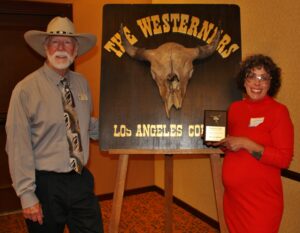
Roundup: July 13 2022
july22_roundup
Roundup Synopsis
July’s Roundup had Denny Thompson take us out on a history of Dodger Stadium. We enjoyed complimentary peanuts and Cracker Jack, but it was hard to root, root, root for the home team as Denny recounted the murky circumstances surrounding the Dodgers’ acquisition of the stadium site—the once vibrant community of Chavez Ravine. City councilman Julián Chávez purchased the rugged ravine in 1844. From its beginnings, Chavez Ravine was a refuge for many peoples. In the 1850s, it hosted a “Pest House” for Chinese and Mexican smallpox victims. Jewish-Americans settled the ravine in the 1860s, but were forced to relocate their cemetery to make room for oil derricks. By 1900, the area was largely Latino, closely knit, and civically engaged. Denny’s own father and grandparents lived in the Ravine at this time, between 1907 and 1922, before winning a dairy farm in Santa Clarita in a poker game. Chavez Ravine residents won a victory against the oil companies in 1926, when the city council banned industry there. However, the community could not resist the next challenges to its integrity. After WW2, city authorities designated Chavez Ravine a “blighted” neighborhood in need of redevelopment. In 1949, the new Los Angeles Housing Authority secured federal funding to build a public housing project on the site. Utilizing eminent domain, the city purchased the land for $10,300 per property. Homeowners felt pressured to accept this price, which dropped if they held out. As consolation, all former residents were promised preferential placement in the proposed housing project upon completion. Yet by the early 1950s, a specter haunted Los Angeles—the specter of communism. At least, that is how it was seen through the redtinted lens of McCarthyite paranoia. Several prominent “Citizens Against Socialistic Housing,” including then-actor Ronald Reagan, successfully pushed for a referendum that killed the Chavez Ravine housing project in 1952. However, Los Angeles had signed a housing contract with the U.S. government, and in 1954 the Feds only agreed to resell the property to the city for $1.3 million on condition the land be used for “a public purpose.” For 22-year-old city councilwoman Roz Wyman, that purpose was obvious. Los Angeles was a “Big League town” without a Big League baseball team, and needed one badly. Fortuitously for her, the Brooklyn Dodgers were an A-grade team with a D-grade home stadium. Wyman encouraged the Dodgers to move to L.A. in 1957, and team owner Walter O’Malley purchased Chavez Ravine from the city for $494,000 in order to build a new stadium. A 1958 ballot initiative to block the purchase narrowly failed, partly due to wording that confused voters. Sheriffs forcibly evicted the last remaining ten families from Chavez Ravine on May 9th, 1959, a day called “Black Friday” by some. Photos of the Archiga family being dragged out of their home made national headlines, but public sympathy diminished with the revelation that the family owned other properties elsewhere in L.A. Construction of Dodger Stadium was completed in 1962, to the tune of $20 million. The human cost was the exile of a thousand families from Chavez Ravine, the result of broken promises. No alternative public housing project was ever offered. These families were scattered all across Los Angeles, with many members having to split up as dictated by the availability of jobs and housing. The Dodgers, meanwhile, took two decades to find acceptance among Latino Angeleños, but the recruiting of Mexican southpaw pitcher Fernando Valenzuela finally broke the ice in 1980. The community of Chavez Ravine is now a fading memory, but their story is a timeless one concerning questions of eminent domain, public housing, and “public purpose” private property. Many thanks to Denny Thompson for this fascinating discussion. — John Dillon
Photos from the Roundup
TBD
Roundup: May 11 2022
Final-Westerners-May-11-2022-Roundup-Flyer
Roundup Synopsis
Paul Clark took the reins in May, to present us with the exhilarating tale he called “The Rise of the Gasoline Cowboys: Outdoor Motorcycle Recreation in PreWWII California.” A rough and tough subject like this was sure to please those in attendance, just as it must have pleased Ernest Hemingway, to whom the quote which Paul selected is attributed, “There are only three sports: bullfighting, motor racing, and mountaineering; all the rest are merely games.” Let’s get on with the sport, then. Paul described the first motorcycle—and he used the term loosely—as a two-wheeled, steam-powered monstrosity, the painting of which showed two stokers following closely behind to keep it fired; hardly reasonable, but the idea was there. As gasoline engines matured, the concept was revived, this time as a three-wheeled contraption resembling early wheelchairs. The shape we have come to expect was introduced around the turn of the century, and Harley-Davidson and Indian quickly became the premier U.S. brands. In the early years, the motorcycle’s popularity followed its practicality. As it became more reliable and affordable, it became more widespread, with numbers in Los Angeles expanding from a few hundred in 1905, to 3000 in 1910, to 7500 by 1917. The reason for the popularity of L.A. as a haven for enthusiasts was the quality of roads and the quality of the weather; you can get a much better return on investment if you are able to ride year-round, as you can in Southern California. Motorcycle clubs sprang up throughout California starting with the Indian Motocycle Club in Los Angeles in 1904. So new was the fad, that they hadn’t even settled on weather they rode “motor-cycles” or “moto-cycles.” These early clubs were keen to be seen as respectable types, which meant that their members showed up to events in their Sunday best and invited photographers and newsmen to document their fine behavior. The publicity seemed to help with popular acceptance of the new machines. What helped even more were organized rallies exhibiting these bikes’ capabilities. Races on dirt and banked wooden ovals, hill climbs, and desert crossings wowed crowds, and newsreels captured the imagination of the region. Hill climbs were the most popular events, with the Capistrano Hill climb drawing an estimated thirty to fifty-thousand attendees by the early 1920s. While these daredevils were risking life and limb storming up hills, the L.A. Motorcycle Club organized “picnic runs” for its members to cruise sedately on the weekends. Endurance racing became more popular as the cycles improved to the point where they could actually endure. With the onset of Prohibition, an L.A. to Tijuana race was organized and billed as a race to a place “where the bar-rigs are still saturated with stronger stuff than grape juice.” 1920 saw the start of the iconic Big Bear “Hare and Hound” Annual Classic, a midnight run on New Year’s Day that ran until 1960. With the onset of WWII, the motorcycle community packed up and went to war. When they returned, the machines they rode were changing, and so was the country. Motorcycle riding was no longer as respectable as it had been prior to the war, and the culture surrounding it changed drastically from its original form. Like with so much else, the Second World War had forever altered part of the American lifestyle. — Alan Griffin
Photos from the Roundup
TBD
Roundup: April 13 2022
Westerners-Aug-2023-Roundup-1
Roundup Synopsis
April’s Roundup saw the corral miss out, yet again, on the long-awaited “Postcards from Mecca” presentation by Steve Lech (don’t worry, it’s coming soon). Johnny-onthe-spot, however, was Brian-on-the-spot, as Dr. Dillon regaled us with his tale of an American hero, Navy Admiral Fightin’ Bob Evans. As Brian told it, it was Evans, not Jesse James nor Billy the Kid, who was the most famed pistolero 120 years ago, and we sure found out why. Fightin’ Bob’s story began in Virginia, where he was born Robley Dunglison Evans, in 1846. After being expelled from school for fighting at age thirteen, Bob’s uncle suggested a career in the Navy. Unfortunately, both Naval Academy seats allotted to Virginia were already filled. Bob agreed to move to Utah, as it was the only territory with allotments available. It was to be a fateful decision. Prior to the Transcontinental Railroad, wagon trains were the name of the game, and so it was with the party that Evans accompanied out west. Wagon trains, however, were vulnerable to Indian raids. Just such an attack befell Evans’ train upon leaving Ft. Laramie, after a wagon got mired in the mud. Thirteen-year-old Evans killed a man in his escape, made it back to the fort, and set out again with just a single wagon. His party was attacked again and Bob was shot in the ankle by an arrow, his foot pinned to the mule he was riding. Eventually, he made it to Salt Lake City where he established residence. Young Evans entered the Naval Academy in 1860. He was trained aboard the USS Constitution, “Old Ironsides.” The Civil War interrupted his tutelage, however, and half his class left to join the Confederacy. Evans stayed true to the Union and ended up fighting his own brother in the rebel navy. As a junior officer taking part in the assault on the “Rebel Gibraltar,” Ft. Fisher, North Carolina, Evans led an assault party of sixty-two sailors and marines. Horribly outgunned and isolated on the beach, his assault force was cut down, with 58 men killed or wounded. Evans was one of only eight men to breach the rebel fort, although he was shot four times for his efforts. He killed the sniper who had wounded him with a miraculous pistol shot from his Whitney .36 Navy revolver. Bob was left for dead on the beach, but was finally rescued and taken to a hospital. He threatened to shoot anyone trying to amputate his legs, so he kept them, along with two bullets that couldn’t be removed. His wounds forced him to use two canes for the rest of his life. Evans moved quickly through the ranks thereafter, taking postings throughout the world, and eventually commanded a gunboat, the USS Yorktown. It was on the Yorktown that he earned his appellation. His refusal to back down during a tense standoff with Chilean warships left him known as “Fightin’ Bob” ever after. After taking a leading role in the largest naval battle of the Spanish-American War, Bob reached the pinnacle of his career when he was given command of the Great White Fleet. Under Admiral Evans’ command, the the Atlantic and Pacific Fleets were combined for the first time in May 1908, in San Francisco Bay. This achievement marked a turning point for San Francisco in its postearthquake rebuilding, and also a bridging of the gulf between America’s East and West. If you’d care to read more about this American hero on both land and sea, you should pick up his autobiographies, A Sailor’s Log and An Admiral’s Log. I’m sure I’m not alone in my anticipation for what Brian Dillon has in store the next time someone calls in sick and he’s called to fill in again. — Alan Griffin


